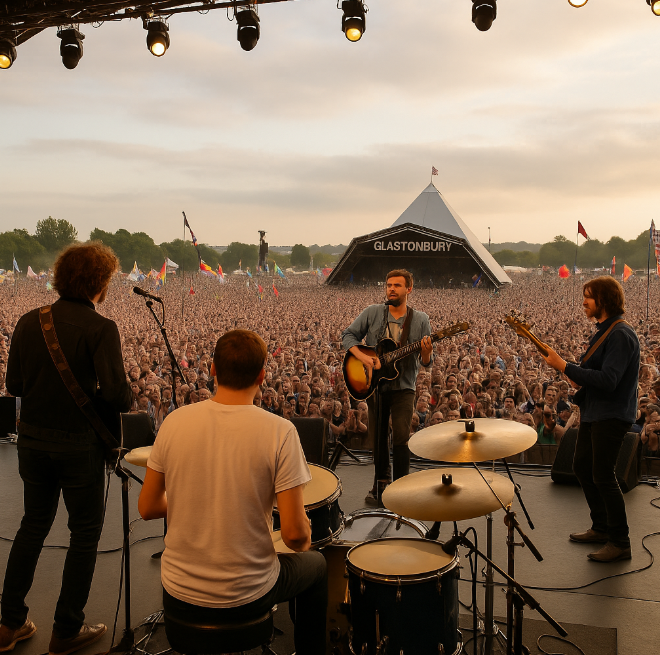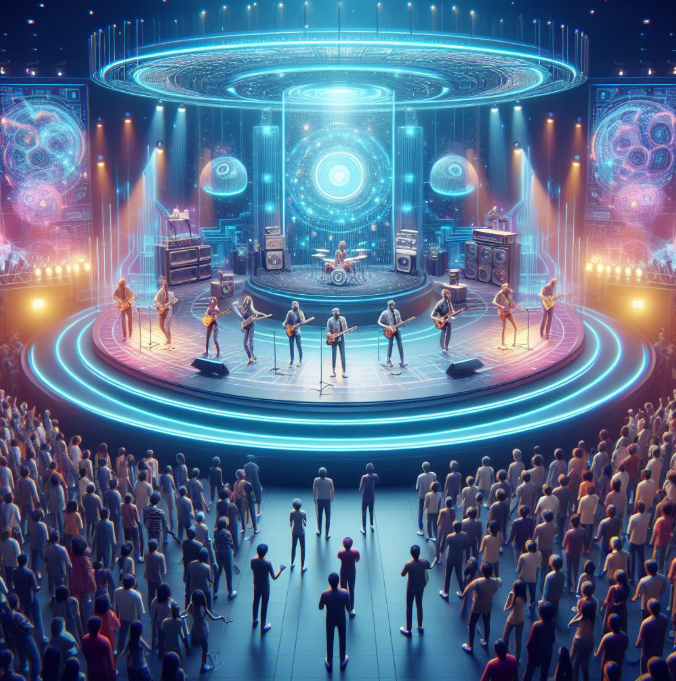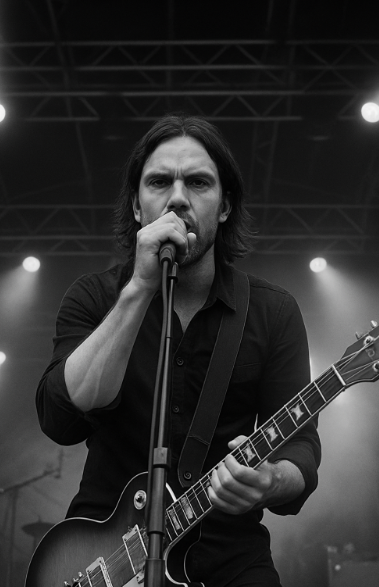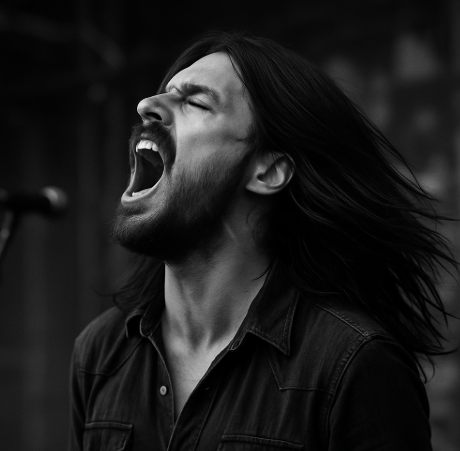from Woodstock to Glastonbury to Virtual Streaming Events
Table of Contents
Woodstock: The Birth of a Cultural Icon
In August 1969, a dairy farm in Bethel, New York, became the stage for one of the most significant gatherings in modern cultural history. Woodstock was originally billed as “An Aquarian Exposition: 3 Days of Peace & Music,” but it quickly grew into far more than a concert. Close to half a million people descended on the site, far exceeding the organisers’ expectations and testing the limits of infrastructure, security, and patience. With food shortages, torrential rain, and traffic jams stretching for miles, the event could have been remembered as a disaster. Instead, it became immortalised as a symbol of hope, unity, and the countercultural movement.
The performers were as legendary as the atmosphere. Jimi Hendrix’s distorted rendition of the Star-Spangled Banner, Joan Baez singing through the night, The Who’s raw power, and Janis Joplin’s electrifying presence all shaped the mythology of Woodstock. Yet what truly defined the event was the spirit of those who attended. At a time of political upheaval, civil rights struggles, and the Vietnam War, Woodstock stood as a defiant declaration that music could create a community beyond divisions. It was chaotic, muddy, and idealistic—but in those imperfections lay its magic. The word “festival” itself was redefined as something more than entertainment: it became a social movement.

Glastonbury: Reinventing the Festival Tradition
While Woodstock became a singular cultural milestone, Glastonbury Festival in Somerset has been an ongoing experiment in reinvention since its first edition in 1970. Michael Eavis, a farmer inspired by Woodstock, hosted 1,500 people for £1 each (including free milk from the farm’s cows). From these humble beginnings, Glastonbury grew into the largest greenfield music festival in the world, regularly attracting over 200,000 attendees. Unlike Woodstock, which lives in memory as a single weekend, Glastonbury thrives in its ability to adapt across generations.
Its defining symbol, the Pyramid Stage, has hosted performances that mark turning points in British cultural history: David Bowie’s 2000 set, Beyoncé’s dazzling headline show in 2011, and Stormzy’s politically charged 2019 performance stand as examples of how the festival reflects and amplifies social change. Beyond the headliners, Glastonbury has always embraced variety—folk, dance, theatre, political debate, and even spiritual healing fields coexist within the festival grounds. Its longevity comes from being more than a series of concerts; it is a sprawling, immersive village where art, activism, and hedonism meet.
The festival has also weathered criticisms—ticket prices, commercialisation, and environmental impact are recurring debates. Yet despite these challenges, Glastonbury continues to resonate because it balances mass appeal with authenticity. Unlike the mythologised Woodstock, Glastonbury lives, breathes, and evolves, serving as both a mirror of contemporary culture and a space for imagining alternatives. Where Woodstock captured the idealism of a single era, Glastonbury has embodied the shifting face of music and society for more than five decades.

The Rise of Virtual Streaming Events
The COVID-19 pandemic of 2020 forced the world of live music into a radical transformation. For the first time in living memory, large-scale gatherings were suspended, and festivals faced mass cancellations. In their place emerged virtual events that reimagined what a music festival could be. Tomorrowland, one of the world’s biggest dance festivals, staged a digital experience complete with virtual stages, animated crowds, and high-definition production values. Independent artists livestreamed from bedrooms and kitchens, creating intimate experiences where global audiences could interact directly through chat windows and emojis. Accessibility became the new buzzword: no muddy fields, no costly travel, no geographical limits—just a screen and an internet connection.
 Yet this shift was not without debate. Critics argued that digital festivals lacked the visceral energy of shared sound waves, the camaraderie of strangers singing together, or the thrill of live spontaneity. The smell of food stalls, the rumble of bass through the ground, and the unpredictable beauty of the outdoors could not be replicated online. But supporters pointed out that streaming democratised access, allowing fans who might never attend a major festival—whether for reasons of cost, disability, or distance—to experience the music. For many artists, virtual shows were also lifelines, keeping them connected to fans and providing revenue during a time of global uncertainty.
Yet this shift was not without debate. Critics argued that digital festivals lacked the visceral energy of shared sound waves, the camaraderie of strangers singing together, or the thrill of live spontaneity. The smell of food stalls, the rumble of bass through the ground, and the unpredictable beauty of the outdoors could not be replicated online. But supporters pointed out that streaming democratised access, allowing fans who might never attend a major festival—whether for reasons of cost, disability, or distance—to experience the music. For many artists, virtual shows were also lifelines, keeping them connected to fans and providing revenue during a time of global uncertainty.
What began as necessity may yet linger as innovation. Streaming platforms are now a permanent part of festival culture, with many organisers embracing hybrid approaches: physical stages paired with global livestreams, online-only line-ups, and interactive digital extras that extend the reach of the festival beyond its physical limits.
What the Future Holds
The future of the music festival is unlikely to be a simple return to past models. Instead, hybrid events may become the norm, blending the electric atmosphere of physical gatherings with the inclusivity of digital access. Imagine a Glastonbury where fans can either camp in Somerset or watch in real time via virtual reality headsets, sharing the same performances across physical and digital divides. This convergence of technology and tradition could transform festivals into year-round communities, not just seasonal events.
Environmental responsibility is another pressing factor shaping the future. Festivals are increasingly under scrutiny for their carbon footprints, waste management, and reliance on mass transport. Organisers are responding with innovations such as banning single-use plastics, promoting public transport, and experimenting with renewable energy sources. The ethos of Woodstock’s idealism and Glastonbury’s activism now intersects with the urgent need for sustainable practice.
Looking further ahead, advances in augmented reality, holographic projection, and AI-driven curation may redefine the very boundaries of performance. A festival might one day feature both living musicians and holographic legends, with audiences curating their own bespoke line-ups in real time. Yet, for all the technological possibilities, the core of the festival experience remains unchanged: the search for connection, for shared rhythm, for collective memory. Whether in a muddy Somerset field, on a farm in upstate New York, or via a screen in one’s living room, the music festival continues to evolve while holding fast to its essence.
✍️ Submit a Guest Post
Not a member yet? You can still share your creative voice with our readers. We welcome guest posts from artists, writers, and creative souls of all kinds.
Submit Your ArticleShare this link with your friends if you enjoyed the post 🙂 See the share buttons below to your right
